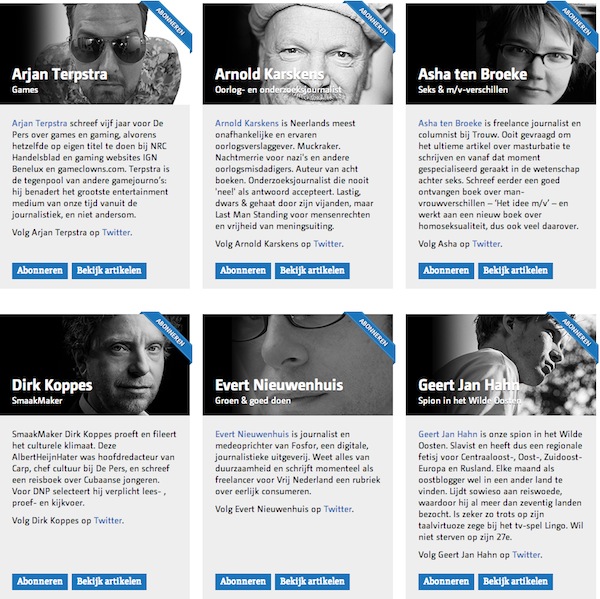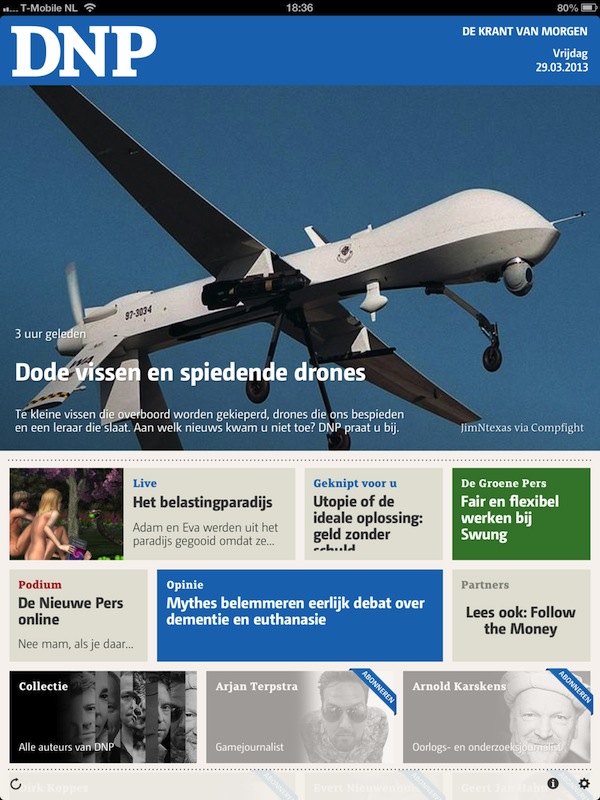“It’s my own little shop, that’s what I like about it. You decide what goes in — like having your own newspaper.”
Arnold Karskens has his own channel on Dutch news startup De Nieuwe Pers (The New Press). For €1.79 a month, readers can subscribe to him and read his war reporting and investigations into war criminals. Don’t care about war crimes? Maybe some of the other journalist-driven channels — on subjects from games to France, from the science of sex to environmental sustainability, from Germany to the euro crisis — would be of interest.
De Nieuwe Pers recently launched in the Netherlands as an online platform for freelance journalists. Users pay €4.49 a month for access to all content on its app or website. But what stands out is the possibility to subscribe to individual reporters, for €1.79 a month. Think True/Slant, but with paywalls.

“News has become more personal,” Alain van der Horst, editor in chief of De Nieuwe Pers, told me. “People are interested in the opinions, the beliefs, the revelations of a certain journalist they know and trust, much more than an anonymous person who writes for a large publication.”
Karskens concurs, stressing that a personal brand is key in this business model. “People read my stuff because I have a clear, crystalized opinion based on over 32 years of war correspondence,” he said. “This really works well for journalists with a distinctive character. It’s not for the average desk slave.”
Van der Horst also thinks paying per journalist is fairer to the readers than subscribing to a publication as a whole. “When you subscribe to a newspaper, you’ll get the full package. Even if you always throw out the sports section, you’ll still get it. With this model you decide: ‘This is what I want to read, so I’ll pay for it — what I don’t read, I don’t pay for.'”
The metaphor isn’t perfect — rather than paying for content on a specific subject, De Nieuwe Pers invites readers to pay by the journalist. Authors have full editorial control over their own channel (“as long as it’s legal,” van der Horst says). Though of all them state a thematic or geographic specialism, those aren’t binding and there are no posting quotas. With this freedom comes unpredictability for the readers — the bang they get for their buck depends on which journalists they subscribe to.
“I do investigative journalism, so sometimes I won’t be able to publish something for a week, sometimes two weeks,” Karskens says. “By subscribing to me personally, people support this type of investigation.”
Until the end of 2013, journalists will receive the full revenue generated by their channels, which includes in-app purchases through Apple’s App Store. Next year, De Nieuwe Pers will start collecting a 25 percent commission. They already take a quarter from the collective subscriptions, with the rest of the money divided among the individual contributors.
In its first few weeks, De Nieuwe Pers has sold about 2,000 subscriptions — about 40 percent of them for channels, the rest for the full collection. (The balance was 20/80 in the very beginning after launch.) The platform wasn’t building its following from scratch, strictly. It’s the descendant of De Pers, a free print newspaper that went out of business in March 2012. Much of De Nieuwe Pers’ editorial staff came from De Pers.

“After we shut down, we got a lot of attention, and readers were telling us they’d be willing to pay for us,” van der Horst said. “It’s encouraging to know that people will pay for digital journalistic work. People often still doubt that, and in many places it’s not yet customary. But it works. People do it as long as they get value for money.”
Though director Jan-Jaap Heij says 2,000 subscribers has De Nieuwe Pers meeting internal targets for 2013, it doesn’t take mathematical genius to figure out it’s not enough to support 17 journalists and a small editorial staff. (At current rates and revenue split, those 2,000 subscribers would generate somewhere north of $100,000 a year.) In the short term, Heij isn’t worried about the money; the company managed to sell some of the technology they developed, and because of its low costs, the bills are covered until late 2014. The authors themselves are free to publish their work elsewhere. “Maybe one or two contributors will get a reasonable income out of this in a year, but for the near future, that’s not our ambition,” said Heij.
For now, Heij’s main goal is further product development. De Nieuwe Pers is set to introduce thematic bundles and a bundle of bundles — the platform’s version of a full newspaper. They’re also expanding their pool of journalists, to cover more themes.
Karskens is the only author who chose to write exclusively for De Nieuwe Pers, and enjoys the freedom of maintaining his channel. “You can be much more personal to your readers,” he said. “They’ve become like friends.” But he says there is one drawback: “Never being able to take a holiday. There’s always the pressure of having to give something to my subscribers.”